
JohnW
-
Posts
23 -
Joined
-
Last visited
Content Type
Profiles
Forums
Blogs
Gallery
Events
Store
Posts posted by JohnW
-
-
Seniority was a strange thing in the German army.
I would say from the card dates and file numbers that on 23.2.39 he was officially to be commissioned from 1.3.39 with a seniority of 1.2.39 #108. That would have been to allow for last minute uniform alterations (surely it was no surprise that he was GOING to be commissioned) and to start off at a neat calendar point.
Many thanks for all your help Rick, it is much appreciated, it helps to make the tunic more than just a piece of material. I had the tunic for a few years before finally trying to decipher the name, and when I got the grave marker photo - I got goose bumps! I'm just hoping that the WASt come up with something too.
John
Unfortunately I cannot get the pic any bigger with a 65k limit!
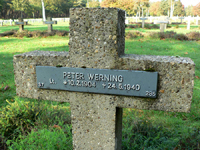
 0
0 -
Here's a pic of the I.R.26 shoulder board showing the Lt rank and reserve grey underlay.
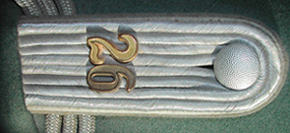
 0
0 -
Nope. There were no "short timers" in the Reichsheer after the "Black Reichswehr" underground training of the very early 1920s.
With active officers in the expanding Wehrmacht of 1933+, ex-NCOs so selected were, after 12 years in the ranks, given a retroactive seniority to their 6th year of service and then almost immediately advanced another rank to Oberleutnant to compensate for their age and recognize their experience. Since reserve officers were "invisible," I don't know what "normal" practice might have been in the same circumstances
but seniority of ten years for a 2nd Lieutenant was unheard of after 1914.
The most likely explanation is a slip of the brain/pen with "2" instead of "3." Happened quite a bit in what would have been boring how-long-until-lunch drudgery.

I see...so he commissioned on 1 Feb 1939 (not '29) and was accepted into the off corps (as a Res. Lt) on 1 Mar 1939 - presumably after a one month officer training course of some type. He surely must have had prior service though to be commissioning at the age of 35! The tunic is dated 23.03.39 BTW, see pic. How many years would someone likely to have served and what rank would they have reached before being considered for commissioning?
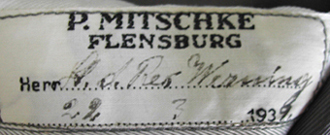
 0
0 -
It's possible he was an ex Reichsheer 12 years NCO subseqquently commissioned, but given normal practice a seniority of 1929 would make no sense.
Those are just file reference numbers.
Odd indeed that they found him in "Losses for Poland-West Balkans" (

 ) but could find nothing else!
) but could find nothing else!Okay, what about...he directly commissioned into the army in 1929 (aged 25) as a Lt., did his service as an officer for a few years (not sure what the length of service was) before being discharged and tx'd to the reserves (this is how we'd do it in the British Army). He was then recalled into the officer corps on 01 Mar 1939. This seems a more likely scenario does it not? I have a tunic to this chap and I am trying to build up a small biography.
0 -
Very interesting. As I understood it, they only release this information to next of kin, so I've never seen this sort of data before.
There are NO Third Reich Rank Lists showing reserve officers, so he was absolutely "invisible" as far as period public records.
Hello Rick,
Many thanks for your speedy assistance. I remember asking last year about this Res. Off and you did say then that a reservist would not be recorded. Well...not to be put off I wrote to the WASt (still waiting for reply...) and also the Bundesarchiv (see letter below). I have proof of this chaps death (photo of his grave in Lommel, Belgium taken this year) and this was what they sent me. I do find it strange that no records are meant to be kept for Reservists though, I mean the Germans were meant to be meticulous with paperwork I thought.
As for the 1929 - I do not think that it is a mistake, more that he joined up in '29, served a few years before passing into the reserve and was commissioned on 01.03.39 after he was recalled. Is that possible? Is the number '3469' (top right), his army number? Also, what do the numbers 1400139 and 23.02.39 refer to (bottom right).
Thank you,
John

 0
0 -
-
-
I've been researching an officer and received these from the Bundesarchiv recently pertaining to the officer in question. Can anybody shed any light on them please? ie what are they and what information do they yield? Many thanks in advance.
John

 0
0 -
Hmmmm, didn't even rock her wheels back.
Maybe she had the brakes on like in the ARTILLERY!!
John
0 -
Hi Aviator

thanks for that, my reference came from a British Newspaper source, and was refering to Ireland in 1830, now I have to wonder did the British count in odd 3-5-7 or even numbers 4-6-8- or did it just refer to at least 3. There must have been a limit to the number of weapons allowed to be grouped together, because if an emergency arose the soldiers had to get there hands on then quickly and not stand around waiting in a Q

Kev in Deva
Dont ya just luv the mystery in history

I have only ever seen rifles stacked in threes - so forty stand of rifles must be 120 rifles altogether. Rifles in those days mustn't have been zeroed - nowadays you cannot simply pick up someone else's weapon!
John
0 -
Nice maker tagged reverse

Just to let you know that when I was posted to Minden, Germany in the mid-80's we used to visit the Steintorstrasse - it is near the Hauptbahnhof and was then frequented by certain ladies
 I do not remember any mounting shops of the medal variety though!
I do not remember any mounting shops of the medal variety though!John
0 -
0
-
Hi Beertje,
have a look at the attached detail of an "aged by time" celanese cover inlay. Normally celanese should not be a subject of an obscure chemical reaction while aging. Your one looks more than "aged by liquid" (my favorite is tea).
Allan is completely right, it is a modern one...
Regards
Matthias
here it is - sold by http://www.regaliaspecialist.com/catalogue...20MERIT%20CROSS aka 'the fake specialist'
John
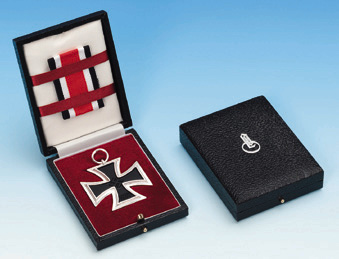
 0
0 -
but still good to have...
http://www.denkmalprojekt.org/Verlustlisten/vl_wk1_index.htm
Chris,
Is there a WW2 version of this anywhere?
Cheers,
John
0 -
Hi,
I have a waffenrock named to a Leutnant der Reserve Werning of 26 Infantrie Regiment. can anyone point me in the right direction to find out more about him. Below is what I have ammassed so far about the unit.
'Formed on 01.10.34 around the old 6.Infanterie-Regiment of the Reichswehr as Infantrie Regiment Flensburg, (before being renamed IR26 on 15.10.36) this unit, composed mainly of Schleswig-Holstein recruits from northern Germany (Wehrkreis X) was earmarked in 1938 to be an advance unit in the proposed invasion of Czechoslovakia. The 3rd Battalion (Major Nickel) was stationed in Flensburg, and the 2nd Bn (Oberst von Dewitz) and 13 (IG) Kompanie (Oberleutnant B?ssemeister) in Schleswig - the 1st Bn (Major Feuring) only being activated on mobilization on August 1st 1939. In Sept.1939, IR26 (Generalmajor Basler) as a part of Heeresgruppe Sud (Generaloberst Gerd von Rundstedt), 8.Armee (General Johannes Blaskowitz), X Armeekorps (General der Artillerie Wilhelm Ulex), the 30th Inf. Div. , led by Generalmajor Kurt von Briesen, saw very heavy action against the cut-off Polish Army in the final stages of the short campaign. After action reports state that with his division stretched to the limits against the counter-attacking Poles, von Briesen personally led his last reserve battalion into the desperate fighting, halting the Poles, but losing his left forearm in the process. Visited in Hospital by Keitel and Hitler, von Briesen was awarded the Knights Cross for his gallantry, and for maintaing the integrity of Blaskowitz's 8.Armee's lines; the first Divisional commander of the war to be thusly awarded. Hereafter, the 30.Infanterie was commonly known as the Briesen Division. The division fought in Belgium in May 1940, and was sent East by June ?41 to be part of X.Armeekorps, Heeresgruppe Nord - the higher formation with which it would stay until the end of the war. It fought at Dvinsk in 1941, and was later encircled, under command of Generalleutnant Emil von Wiekede, for more than a year with II.Armeekorps at Demjansk in January 1942. On 10.12.42 the regiment was amalgamated with IR 6 and renamed Fusilier Regiment 26. In the winter 1942/43 the 2nd Bn was dissolved due to heavy losses and upon being freed from the Demjansk pocket in Feburary ?43, the division fought in the Leningrad Salient, again as part of X.Armeekorps, falling back with the rest of Heeresgruppe Nord through the Baltic states in 1944. On 09.06.44 the 3rd Bn was renamed as the 2nd Bn but in October ?44 the 2nd Bn was again dissolved due to further losses, finally becoming one of the encircled formations of the now re-named Heeresgruppe Kurland of March 1945, fighting in the Kurland Kessel in a defensive role until its eventual surrender after May 9, 1945.
Thank you for any help,
John
0 -
Evening,
I found these on ebay (the seller has a few similar items) and wonder what people think. The buyers id is private (which alarms me) so that they cannot be warned off buying fakes - if thats what they are.
http://cgi.ebay.co.uk/ws/eBayISAPI.dll?Vie...AMEWA%3AIT&rd=1
http://cgi.ebay.co.uk/ws/eBayISAPI.dll?Vie...AMEWA%3AIT&rd=1
John
0


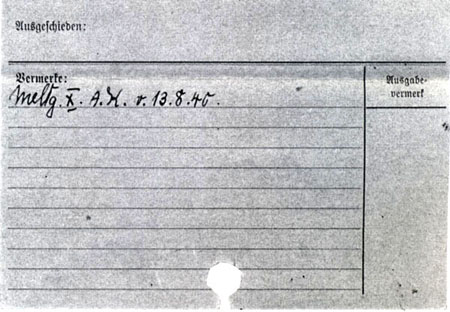
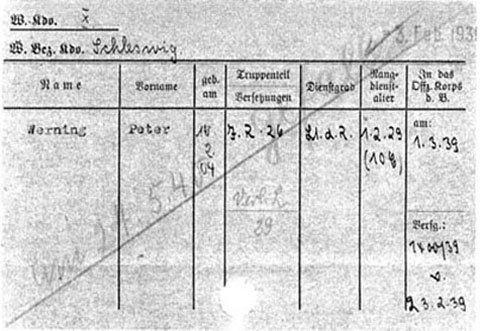


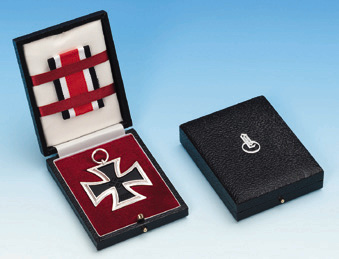
Wolseley Helmet
in Great Britain: Militaria: Badges, Uniforms & Equipment
Posted
I can say with certainty that this flash is not a current TRF/DZ flash.